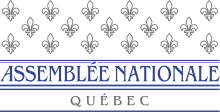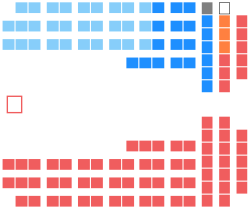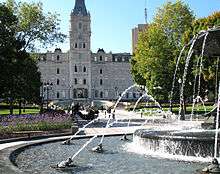National Assembly of Quebec
| Assemblée nationale du Québec National Assembly of Quebec (English) | |
|---|---|
| 41st Quebec Legislature | |
 | |
| Type | |
| Type | |
| History | |
| Founded | December 31, 1968 |
| Preceded by | Legislative Assembly of Quebec |
| Leadership | |
|
J. Michel Doyon Since 24 September 2015 | |
Opposition House Leader | |
| Structure | |
| Seats | 125 members of Assembly |
 | |
Political groups |
Governing Party Opposition Parties |
| Elections | |
| First-past-the-post | |
Last election | April 7, 2014 |
Next election | October 1, 2018 or earlier |
| Meeting place | |
 | |
| Parliament Building, Quebec City, Quebec | |
| Website | |
| www.assnat.qc.ca | |
The National Assembly of Quebec (French: Assemblée nationale du Québec) is the legislative body of the Province of Quebec in Canada. Legislators are called MNAs (Members of the National Assembly; French: députés). The Lieutenant Governor,[1] and the National Assembly compose the Legislature of Quebec, which operates in a fashion similar to those of other Westminster-style parliamentary systems.
The National Assembly was formerly the lower house of Quebec's legislature and was then called the Legislative Assembly of Quebec. In 1968, the upper house, the Legislative Council, was abolished and the remaining house was renamed.
The current President of the National Assembly (equivalent to speaker in other legislatures) is Liberal MNA Jacques Chagnon.
History
The Legislative Assembly was created in Lower Canada by the Constitutional Act of 1791. It was abolished from 1841 to 1867 under the 1840 Act of Union which merged Upper Canada and Lower Canada into a single colony named the Province of Canada.
The Constitution Act, 1867 (formerly the British North America Act), which created Canada, split the Province of Canada into the Provinces of Quebec and Ontario. The Legislative Assembly of Lower Canada was thus restored as the Legislative Assembly of the Province of Quebec.
The original Quebec legislature was bicameral, consisting of the Legislative Council and the Legislative Assembly.
In 1968, Bill 90 was passed by the government of Premier Jean-Jacques Bertrand, abolishing the Legislative Council and renaming the Legislative Assembly the "National Assembly", in line with the more strident nationalism of the Quiet Revolution. Before 1968, there had been various unsuccessful attempts at abolishing the Legislative Council, which was analogous to the Senate of Canada.
In 1978, television cameras were brought in for the first time to televise parliamentary debates. The colour of the walls was changed to suit the needs of television and the salon vert (green hall) became the salon bleu (blue hall).
Parliament Building
Constructed between 1877 and 1886, the Parliament Building features the Second Empire architectural style[2] that was popular for prestigious buildings both in Europe (especially France where the style originated) and the United States during the latter 19th century. Although somewhat more sober in appearance and lacking a towering central belfry, Quebec City's Parliament Building bears a definite likeness to the Philadelphia City Hall, another Second Empire edifice in North America which was built during the same period. Even though the building's symmetrical layout with a frontal clock tower in the middle is typical of legislative institutions of British heritage, the architectural style is believed to be unique among parliament buildings found in other Canadian provincial capitals . Its facade presents a pantheon representing significant events and people of the history of Quebec.

Additional buildings were added next to the Parliament Buildings:
- Édifice André-Laurendeau was added from 1935 to 1937 to house the Ministry of Transport.
- Édifice Honoré-Mercier was added from 1922 to 1925 to house the Ministries of the Treasury (Finances), the Attorney General and the Secretary General of the National Assembly.
- Édifice Jean-Antoine-Panet was added from 1931 to 1932 for the Ministry of Agriculture.
- Édifice Pamphile-Le May added from 1910 to 1915 for the Library of the National Assembly, various other government offices and for the Executive Council.
Elections
General elections are held every five years or less. Any person holding Canadian citizenship and who has resided in Quebec for at least six months qualifies to be on the electoral list.
Normally, the leader of the political party with the largest number of elected candidates is asked by the Lieutenant-Governor of Quebec to form the government as premier. (In French, it is rendered as premier ministre. The term "prime minister" is commonly used by the government as a literal translation of the French term. In Canada's other provinces, whose heads of government are referred to in English as "premier", the title is similarly rendered "premier ministre" in French, too. The term literally means "First Minister," a term in Canada when referred to plural, "First Ministers," refers collectively to the Provincial Premiers and the Prime Minister of Canada).
Quebec's territory is divided into 125 electoral districts (ridings). In each riding, the candidate who receives the most votes is elected and becomes a Member of the National Assembly (MNA). This is known as the first-past-the-post voting system. It tends to produce strong disparities in the number of seats won compared to the popular vote, perhaps best exemplified by the 1966, 1970, 1973, and 1998 elections.
Quebec elections have also tended to be volatile since the 1970s, producing a large turnover in Assembly seats. Consequently, existing political parties often lose more than half their seats with the rise of new or opposition political parties. For instance, the 1970 and 1973 saw the demise of the Union Nationale and rise of the Parti Québécois which managed to take power in 1976. The 1985 and 1994 elections saw the Liberals gain and lose power in landslide elections.
Members
Seating Plan
Members of the National Assembly (MNAs) swear two oaths: one to the Canadian monarch as Quebec’s head of state, and a second one to the people of Quebec. Previous Parti Québécois premier René Lévesque added the second oath.[3]
Most recent election
| Party[5] | Party leader[5] | Candidates[4] | Seats | Popular vote | |||||||
|---|---|---|---|---|---|---|---|---|---|---|---|
| 2012 | Dissol. | 2014 | Change | % | Number | % | Change (pp) | ||||
| Liberal | Philippe Couillard | 125 | 50 | 49 | 70 | +21 | 56.00 | 1,757,071 | 41.52 | +10.32 | |
| Parti Québécois | Pauline Marois | 124 | 54 | 54 | 30 | -24 | 24.00 | 1,074,120 | 25.38 | -6.57 | |
| Coalition Avenir Québec | François Legault | 122 | 19 | 18 | 22 | +4 | 17.60 | 975,607 | 23.05 | -4.00 | |
| Québec solidaire | Françoise David, Andrés Fontecilla† | 124 | 2 | 2 | 3 | +1 | 2.40 | 323,124 | 7.63 | +1.60 | |
| Option nationale | Sol Zanetti | 116 | — | — | — | — | — | 30,697 | 0.73 | -1.16 | |
| Green | Alex Tyrrell | 44 | — | — | — | — | — | 23,163 | 0.55 | -0.44 | |
| Conservative | Adrien Pouliot | 59 | — | — | — | — | — | 16,429 | 0.39 | +0.21 | |
| Independent | 11 | — | 2 | — | — | — | 15,361 | 0.36 | +0.09 | ||
| Parti nul | Renaud Blais | 24 | — | — | — | — | — | 7,539 | 0.18 | +0.12 | |
| Bloc Pot | Hugô St-Onge | 14 | — | — | — | — | — | 2,690 | 0.06 | +0.05 | |
| Marxist–Leninist | Pierre Chénier | 24 | — | — | — | — | — | 2,016 | 0.05 | ±0.00 | |
| Parti équitable | Patricia Domingos | 5 | — | — | — | — | — | 1,645 | 0.04 | +0.04 | |
| Parti des sans Parti | Frank Malenfant | 5 | — | — | — | — | — | 1,291 | 0.03 | -0.09†† | |
| Mon pays le Québec | Claude Dupré | 6 | * | — | — | * | — | 521 | 0.01 | * | |
| Autonomist Team | Guy Boivin | 5 | — | — | — | — | — | 400 | 0.01 | -0.04 | |
| Unité Nationale | Paul Biron | 3 | — | — | — | — | — | 241 | 0.01 | -0.02 | |
| Quebec – Democratic Revolution | Robert Genesse | 1 | — | — | — | — | — | 163 | 0.00 | -0.01 | |
| Parti indépendantiste | Michel Lepage | 1 | — | — | — | — | — | 126 | 0.00 | -0.03 | |
| Quebec Citizens' Union | Marc-André Lacroix | 1 | — | — | — | — | — | 58 | 0.00 | -0.05 | |
| Total | 814 | 125 | 125 | 125 | 0 | 100.00 | 4,232,262 | 100.00 | |||
| Valid ballots | 4,232,262 | 98.54 | -0.24 | ||||||||
| Rejected ballots | 62,793 | 1.46 | +0.24 | ||||||||
| Voter turnout | 4,295,055 | 71.44 | -3.16 | ||||||||
| Registered electors | 6,012,440 | ||||||||||
Notes:
- † The party designates David and Fontecilla as co-spokespeople. The party's power is held by the general meetings of the members and a board of 16 directors; the de jure leader recognized by the Chief Electoral Officer of Quebec (DGE) is Pierre-Paul St-Onge.[5]
- †† Party contested the 2012 election under the name Coalition pour la constituante.
- * Party did not nominate candidates in the previous election.
Changes during the 41st Quebec Legislature
| Number of members per party by date |
2014 | 2015 | ||||||||||||||
|---|---|---|---|---|---|---|---|---|---|---|---|---|---|---|---|---|
| Apr 7 | Aug 15 | Sep 29 | Oct 20 | Feb 26 | Mar 9 | Apr 7 | Jun 8 | Aug 21 | Aug 24 | Aug 26 | Sep 3 | Sep 22 | Oct 22 | Nov 9 | ||
| Liberal | 70 | 69 | 71 | 70 | 69 | 68 | 71 | |||||||||
| Parti Québécois | 30 | 29 | 30 | 29 | 28 | 29 | ||||||||||
| Coalition Avenir Québec | 22 | 21 | 22 | 21 | 20 | |||||||||||
| Québec solidaire | 3 | |||||||||||||||
| Independent | 0 | 1 | ||||||||||||||
| Total members | 125 | 124 | 123 | 124 | 123 | 124 | 123 | 125 | 124 | 123 | 122 | 121 | 120 | 124 | ||
| Vacant | 0 | 1 | 2 | 1 | 2 | 1 | 2 | 0 | 1 | 2 | 3 | 4 | 5 | 1 | ||
| Government majority | 15 | 16 | 17 | 16 | 15 | 14 | 15 | 17 | 16 | 15 | 16 | 15 | 16 | 18 | ||
Proceedings
One of the members of the National Assembly is chosen as the President of the Assembly (a post called Speaker in most other Westminster System assemblies) by the Premier with the support of the Leader of the Opposition. The President of the Assembly is the arbiter of the parliamentary debates between the members of the government and the members of the Opposition. In order for a member to address a member of the other side, he or she has to speak through the President of the Assembly. The President is usually a member of the governing party, although there is no requirement for this.
The proceedings of the National Assembly are broadcast across Quebec on the cable television network Canal de l'Assemblée nationale.
See also
- Executive Council of Quebec
- List of Quebec general elections
- List of Quebec premiers
- List of Quebec leaders of the Opposition
- Politics of Quebec
- Timeline of Quebec history
References
- Specific
- ↑ An Act respecting the National Assembly, CQLR 1982, c. A-23.1, s. 2 .
- ↑ Useful Information - National Assembly of Québec. Assnat.qc.ca (2012-10-29). Retrieved on 2013-07-12.
- ↑ http://www.montrealgazette.com/news/government+Quebecers+Couillard+says/9750667/story.html
- 1 2 "General elections". DGE. Retrieved May 7, 2014.
- 1 2 3 "Political parties". DGE. Retrieved March 5, 2014.
- Bibliography
- Assemblé nationale du Québec (2000). What is the National Assembly?, Québec: Assemblée nationale, 58 p. (ISBN 2-550-30165-X)
- Deschênes, Gaston (1983). The Assemblée nationale: Its Organization and Parliamentary Procedure, Québec: Assemblée nationale, 53 p. (ISBN 2551047595) [1st ed. in 1977]
External links
- National Assembly of Quebec website (English)
- National Assembly historical data (French)
- Diagram of the positions in the Assembly (French)
- Data about the current president of the Assembly